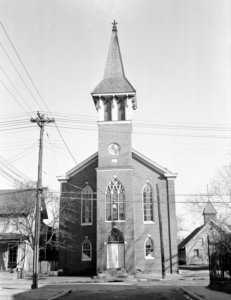
Asbury United Methodist Church. Photo from H. Robins Hollyday collection.
Asbury United Methodist Church, Easton
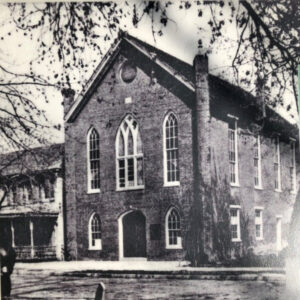
Bethel AME in the early 1900s. Photo from Church Marker.
Bethel African Methodist Episcopal Church, Easton
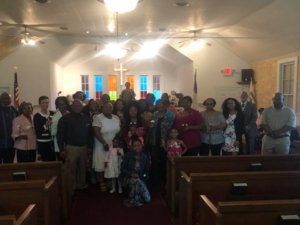
New Queen Esther Congregation in 2019.
New Queen Esther African Methodist Episcopal Church, Ivytown
In 1840 a log cabin, was built in Ivytown as place of worship. Prior to this members of the Ivytown community worshipped in their homes. In 1851 the Queen Esther A.M.E. Church ministry was established at its present location. When that physical structure burned, another building was erected on the same site, and the church was renamed New Queen Esther A.M.E. Church in 1935. More information can be found on the church’s website and Facebook page.

St. Johns United Methodist Church. Photo from 66th anniversary event program (1963).
New St. John’s United Methodist Church, Wittman
In 1804 the first black church in the Bay Hundred area – St. John’s Methodist Church — was built by John & Mary Kersey. In 1897 when all-white congregation at nearby Asbury Church moved to another church location, St. John’s moved into the vacated facility and the original church became the St. John’s parish house. In 1986, the 3 black congregations, St. James UMC of Sherwood, John Wesley UMC of McDaniel, and St. John’s UMC of Wittman, merged at St. John’s, and the church name was officially changed to New St. John’s United Methodist Church. More information can be found on their Facebook page.
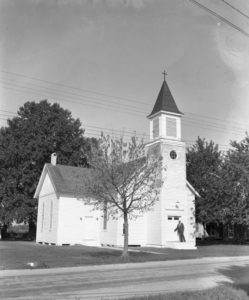
Scotts United Methodist Church in 1952. Photo from Laird Wise collection.
Scotts United Methodist Church, Trappe
The grounds on which the church stand have been used for religious services for nearly 300 years. It was first called “The Friends Meeting House,” used by Quakers beginning the 17th century. After they moved to Easton, the church grounds were turned over to the African American congregation of the Methodist Episcopal Church. In 1869 the former structure was built and was set up under the Delaware Conference. The church was named Scott after the presiding Bishop Levi Scott. Scotts Methodist Episcopal Church, now named Scotts United Methodist Church, is noted for Emancipation Day Celebrations, also known as “Nace’s Day” which were spearheaded by Nathaniel Hopkins in 1867 with a parade and held annually since then, expanded to include worship, music, parade, food, exhibits, etc. More information can be found on their website and Facebook page.
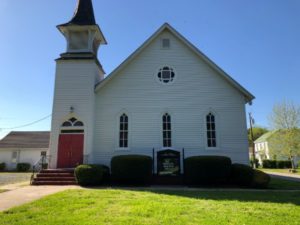
St. Luke United Methodist Church. Photo from 2019.
St. Luke United Methodist Church, Bellevue
The church that was to become St. Luke Methodist Church at Bellevue was built around 1860 on Ferry Neck Road (a mile from Bellevue-Royal Oak Road) by whites for the African American community. After the Civil War, the congregation became more segregated when white members requested the African American members to move the original church from Ferry Neck away from their replacement church. Elizabeth Harrison permitted the church building to be moved onto a small portion of her property about a half-mile away. The church prospered through the years as more families arrived at Bellevue. In 1903 construction of the church at the present location was completed and the church was dedicated under the leadership of Rev. Abraham Chase. In 1962 the Bellevue-Royal Oak charge was divided. St. Luke of Bellevue went to Oxford and St. Paul went to St. Michaels. In the 1970s, St. Luke went to the Easton charge and about 1982 was rejoined. St. Luke U.M. Church is the oldest structure standing in the Bellevue community. More information can be found on their Facebook page.
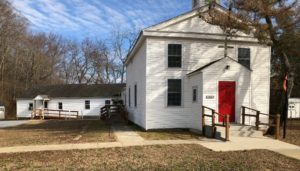
St. Matthew United Methodist Church. Photo taken in 2019.
St. Matthew United Methodist Church, Longwoods Road, Easton
In the early 1800s MacGee Chapel was built in the village of Longwoods. The church name evolved over the years from MacGee Methodist Episcopal Church in the 1830s, to MacGee Chapel in 1880, to MacGee Methodist Episcopal Church in 1885, and McGee Chapel Methodist Church in 1957. The MacGee Chapel’s original balcony remains in the building. The generosity of white landowners allowed the church to be built on their property and after more than one hundred years the property was deeded to the black community. In 1957 the church was deeded to the Trustees for the amount of $1.00 from Wiliam and Della Vorwald. In 1988 the four small churches on the charge merged: Dashields Methodist Episcopal in Copperville, Staten’s Chapel in Matthewstown, John Wesley in Chapel, and McGee in Longwoods. From this merger the St. Matthew United Methodist Church was created. More information can be found here.
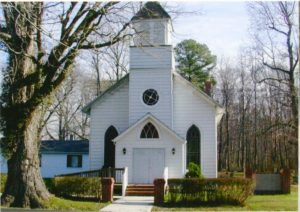
St. Stephen’s A.M.E. Church in 2004. Photo by Harriette Lowery
St. Stephen’s African Methodist Episcopal Church, Unionville
In 1871 the first sanctuary in Unionville was erected, but it was destroyed by fire the same year. The church was built by the 18 ex-slaves and free blacks who fought for the Union in the United States Colored Troops and who returned from the US Civil War and established the community of Unionville. Quakers Ezekiel and Sarah Cowgill and their sons leased to each of the 18 soldiers a plot of land at the rate of one dollar a year for 30 years with the stipulation that they build a church and school in the community. In 1873 the replacement church was built and remains in use today. Bishop Alexander Walker Wayman consecrated the church in 1873. He was the 7th Bishop of the AME Church and a personal friend of Frederick Douglass. Initially the church was referred to as the “African Methodist Church.” By 1896 the church was called “Unionville AME Church.” Today it is known as “St. Stephen’s African Methodist Episcopal Church.” The church is the oldest remaining structure in the historic village of Unionville, which was founded and built by African Americans. All 18 soldiers of the U.S. Colored Troops who returned from the Civil War are buried in the cemetery of St. Stephen’s A.M.E. Church. More information can be found on their website and Facebook page.
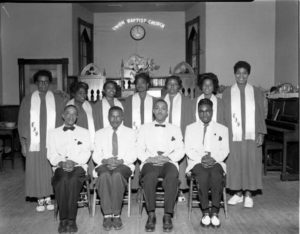
The Twilight Jubilee Singers from Union Baptist Church. Photo from H. Robins Hollyday Collection (1953-1959).
Union Baptist Church, Easton
In 1887 the church was organized by Raleigh Jones, Henry Potter, Samuel Smothers, with services held in the home of Henry and Margaret Potter. Later that same year the first building for Union Baptist Church was deeded to the Colored Baptist Congregation, which was erected in Kirkham. The church has relocated a few times since then, to Hammond Street in 1908, and Glenwood Ave in 1982. In 1960-1965, during the pastorate of Rev. Serenus T. Churn, Union Baptist Church initiated the Civil Rights Movement. The pastor included the entire community in breaking down racial barriers in Talbot County. From 1965-1978, during the pastorate of Rev. Dr. William Revely, Union’s strength in singing and music elevated. The choir made an album, the recording artist Rev. Isaac Douglas and his pianist Freddie Washington worked closely with the choir and were instrumental in bringing music workshop leader, the late Rev. James Cleveland, to Easton. More information can be found on their website and Facebook page.
Union United Methodist Church, St. Michaels
The Union United Methodist Church emerged from the first Methodist church built in St. Michaels (1782-84), where the south gallery was reserved for black people. In 1852 a lot was leased on Fremont Street in St. Michaels by the trustees of Sardis Chapel, who held all the church property of the black church until the mid-1860s. Through the efforts of Rev. J.D. Long and Miss Louisa Hambleton, a chapel was erected on the lot and dedicated on July 4, 1852. The chapel was named “Long’s Chapel” after Rev. J.D. Long. In 1864 the Sardis Chapel trustees conveyed the property of the black congregation to the Delaware Conference. The first pastor appointed by the Delaware Conference was Rev. Benjamin Gibbs in 1865. During the same year the church was renamed Union Methodist Church. In 1895, after other building modifications, the church was moved to its present location on the corner of Railroad and Fremont Streets. In 1962 the Union Methodist Church was placed on a circuit. When the Bellevue-Royal Oak charge was dissolved and Bellevue was placed with Oxford, the Royal Oak Church was placed with Union Methodist Church in St. Michaels. More information can be found on their website and Facebook page.

Waters UMC Congregation.
Waters United Methodist Church, Oxford
In 1883 Waters Methodist Episcopal Church was organized following the membership split at John Wesley M.E. Church at Oxford Neck attended by blacks and whites. The split occurred when St. Paul’s Church was built in Oxford as the white church. That same year the black members organized Waters Methodist Episcopal Church, under the pastorate of Rev. D. G. Waters, who also served the John Wesley Church. In 1901 the church was incorporated, and a few years later in 1908 the old church building was renovated and an addition was added creating the present edifice. In 1948 the church erected a Parish Hall. Upon completion of the new building, the church, under the pastorate of Rev. A.L. Scriber, hosted the Annual Session of the Easton District Conference in Oxford. The church has had 42 pastors from 1883 to 2019, with each bring profound changes to the church and its members. More information can be found on their Facebook page.
Further Reading
Books
- Climbing Jacob’s Ladder: The Rise of Black Churches in Eastern American Cities, 1740-1877 by Edward D. Smith. (Smithsonian Institution Press: 1988.)
Web Resources
- The Black Church
- A feature from PBS as part of their “American Experience.”
Sources
These profiles were written with information compiled by board member Dr. Willie Woods for our African American exhibit.
